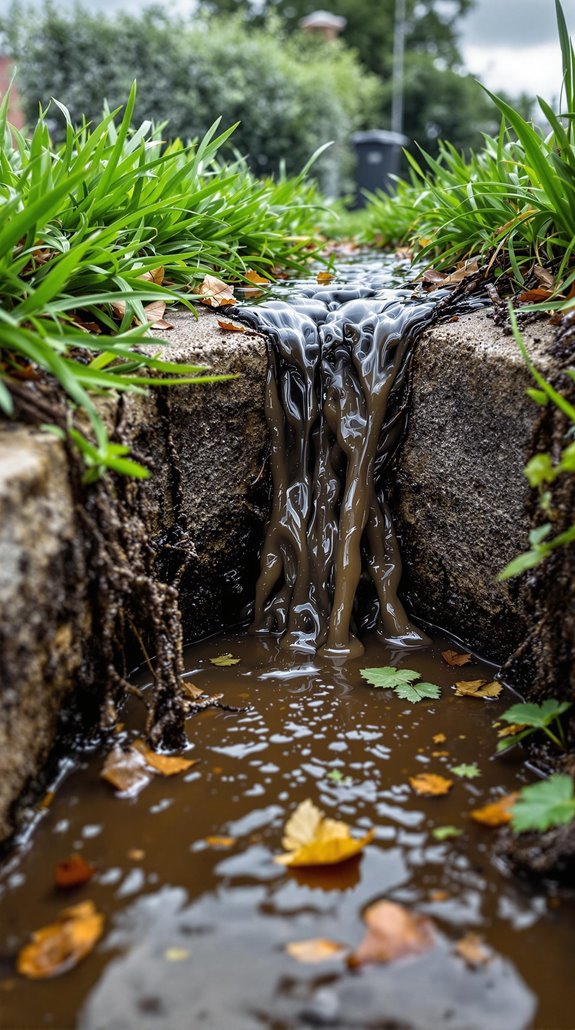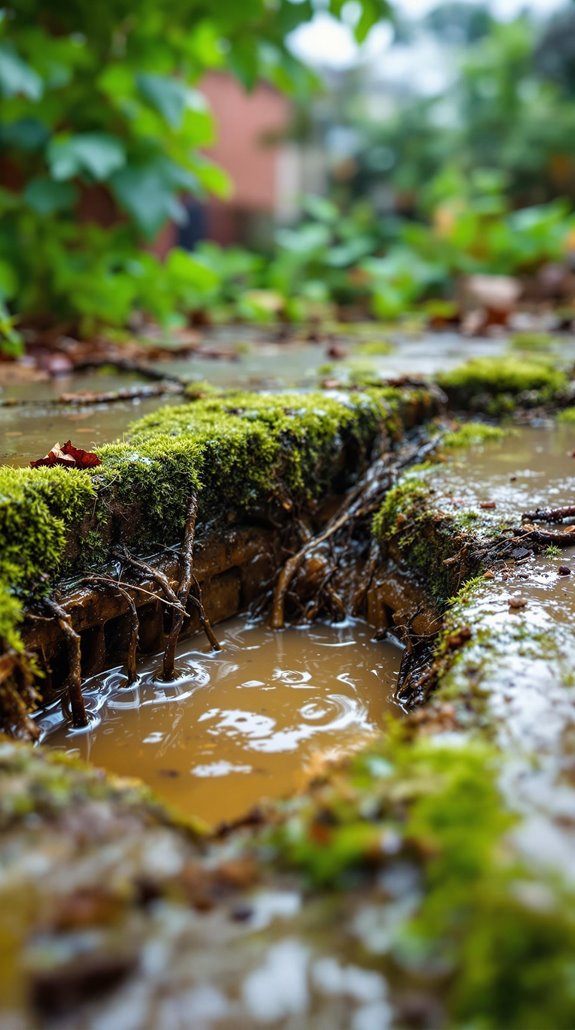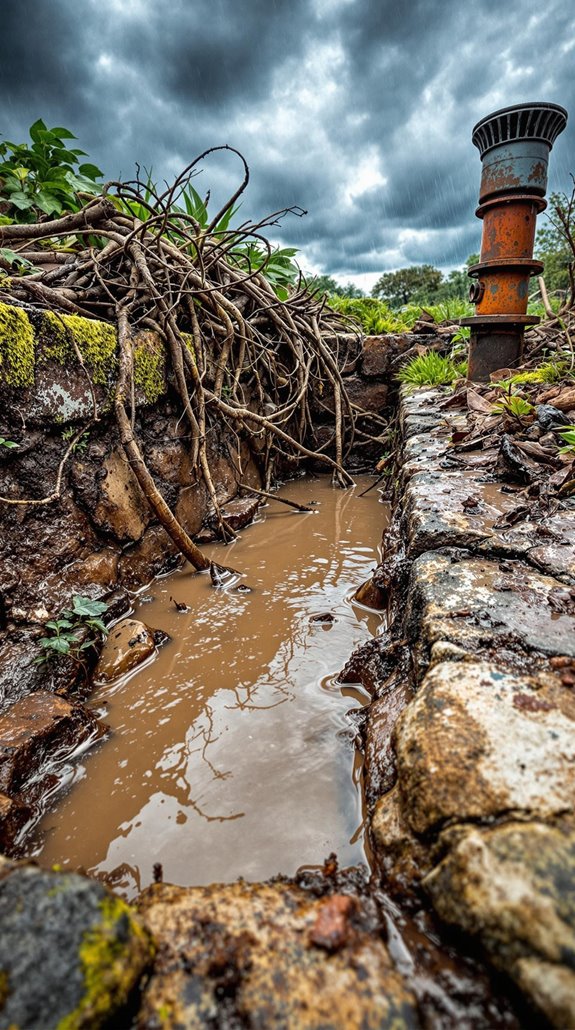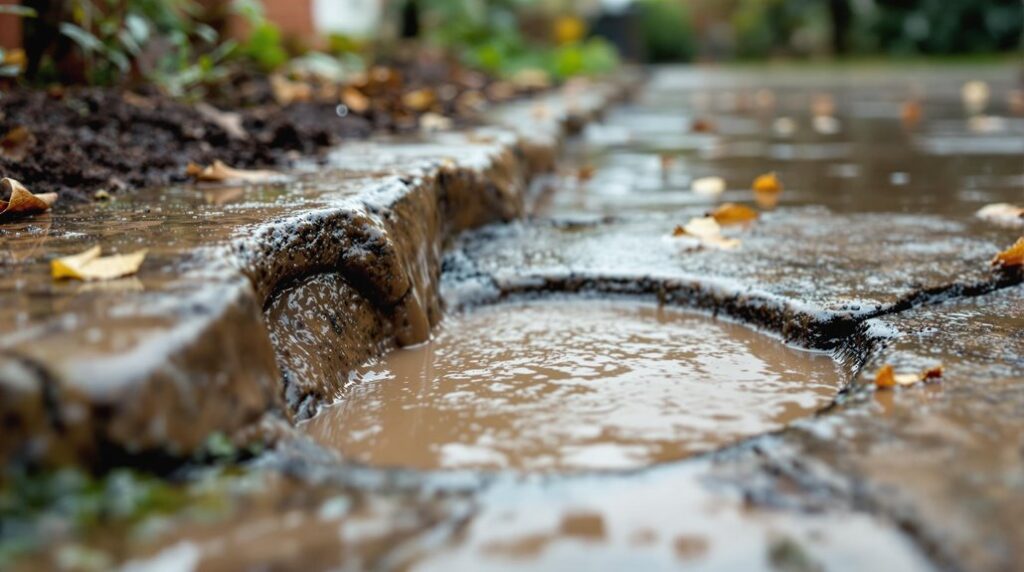I’ve seen countless homeowners panic when their rainwater soakaway starts overflowing, turning their gardens into muddy swamps and threatening their property’s foundation. The good news? Most soakaway failures aren’t catastrophic system collapses—they’re fixable problems with identifiable causes and practical solutions. Whether you’re dealing with debris blockages, inadequate drainage capacity, or soil saturation issues, there’s a systematic approach to diagnosing and resolving your overflow problem before it escalates into costly structural damage.
Key Takeaways
- High-pressure water jetting effectively removes silt and debris blockages that cause soakaway overflow problems.
- Clear accumulated leaves, branches, and organic matter from drainage areas through quarterly debris removal maintenance.
- Install silt traps and catch-pits to prevent future blockages and protect soakaway filtration capacity.
- Use enzyme-based drain cleaners to naturally break down organic material causing drainage restrictions.
- Call professionals immediately if water pooling persists, foul odors develop, or structural damage occurs.
Why Your Soakaway Is Overflowing: Common Causes Explained

When your soakaway starts overflowing, it’s typically signaling that one or more critical components have failed within the drainage system. I’ve identified five primary culprits that cause these frustrating drainage failures.
Debris accumulation tops the list—leaves, branches, and silt clog your system’s filtration capacity, creating stagnant water that can’t percolate properly. Root infiltration presents another serious threat, as tree roots penetrate pipes and compromise structural integrity, often requiring complete removal to restore function.
Inadequate sizing or design flaws mean your soakaway simply can’t handle peak flow rates during storms. Age-related deterioration affects systems over 25 years, reducing percolation efficiency. Finally, environmental stressors like high-intensity rainfall and prolonged ground saturation can overwhelm even well-maintained systems, especially when groundwater levels rise during wet periods.
Beyond property damage, overflowing soakaways can create legal disputes when water floods onto neighboring properties, making prompt resolution essential for avoiding costly complications.
Warning Signs That Your Soakaway System Is Failing
Understanding what causes soakaway overflow prepares you to spot the warning signs before complete system failure occurs. I’ll help you identify these critical indicators so you can act quickly.
Watch for standing water or flooding around your drainage field, especially after moderate rainfall. You’ll notice soft, boggy ground where it should be firm, and your lawn may stay persistently waterlogged. Inside your home, toilets flush slowly, drains gurgle, and showers empty sluggishly.
Foul odors from drains, manholes, or the soakaway area signal serious problems. You might see unusually lush grass growth over your drainage field – vegetation thrives on the excess nutrients from surfacing effluent.
If your septic tank needs emptying more frequently or alarm beacons illuminate, your soakaway isn’t processing wastewater effectively. Look for visible ground dips around your soakaway area, as these indicate soil compaction that prevents proper water absorption.
Effective Methods to Unblock Your Overflowing Soakaway

Once you’ve identified the warning signs, you’ll need to take decisive action to restore your soakaway’s functionality. I’ll guide you through the most effective unblocking methods we drainage professionals rely on.
Start with high-pressure water jetting – it’s your first line of defense against silt and debris blockages. Direct pressurized water jets into pipes and backwash the system to drag trapped material out of soakaway crates.
For stubborn organic blockages, I recommend enzyme-based drain cleaners that break down fats and leaves naturally. If excavation’s necessary, you’ll physically clear obstructions and replace damaged components like torn membranes or collapsed pipes.
Don’t overlook system upgrades – installing silt traps upstream prevents future blockages, while catch-pits make maintenance easier. Always wear protective clothing when handling any chemical drain cleaners or caustic solutions during the unblocking process.
Essential Maintenance Tips to Prevent Future Overflow Problems
Since prevention costs far less than emergency repairs, I’ll show you the maintenance strategies that keep soakaways functioning reliably year-round.
I recommend establishing monthly inspections by lifting covers to check for silting and contamination. You’ll want to remove accumulated debris quarterly and clear vegetation within a one-meter radius bimonthly. Regular inspections help identify common problems that could lead to overflow issues.
For long-term protection, line your soakaway crates with non-woven geotextile membrane and secure seams with waterproof tape. Install leaf guards over downpipes to intercept organic matter before it enters your system.
Create a catch pit before inlet pipes to intercept silt, and guarantee you’ve got ≥400mm gravel covering your crates. Document every inspection and repair—this tracking helps you identify patterns and adjust maintenance frequency based on seasonal debris accumulation. Schedule annual inspections with qualified drainage engineers to ensure your soakaway remains compliant with building regulations and functions at peak efficiency.
When to Call Professionals for Soakaway Repairs

While regular maintenance prevents most soakaway failures, certain warning signs indicate you’ve moved beyond DIY territory into professional repair requirements. I recommend calling experts when you notice persistent water pooling, foul odors, or sinkholes around your drainage area – these signal serious structural damage that DIY efforts can’t resolve.
If your drainage issues keep returning despite your best cleaning attempts, or if you’re experiencing ongoing flooding after partial repairs, you’re dealing with systemic problems. Tree root infiltration, collapsed chambers, or pipe fractures require specialized equipment like CCTV surveys and hydro-jetting.
Don’t overlook design flaws either. Undersized soakaways, improper slopes, or non-compliant installations need professional assessment. I’ve seen too many homeowners waste time and money on temporary fixes when the real solution requires engineering expertise and proper diagnostics. Professional CCTV surveys can accurately identify the condition of soakaways and drainage paths to determine the most effective repair approach.
Best Practices for Proper Soakaway Installation and Setup
Professional repairs become necessary when problems stem from poor initial installation, which explains why getting your soakaway setup right from the start saves you significant headaches and costs down the road.
I’ll share the critical installation practices that separate successful soakaways from problem systems. First, you’ll need to conduct a percolation test to determine proper sizing and choose the lowest drainage point on your property. During excavation, I recommend creating a stable 150mm base layer using 20mm pea shingle.
The membrane installation requires careful attention—wrap your crates completely with non-woven geotextile, sealing all joints and pipe entries. Install a silt trap upstream for debris capture, and maintain 150mm backfill thickness around all crate sides for ideal performance. Remember to position your soakaway at least 5 meters distance from your property and any underground services to ensure safe and effective drainage.
Conclusion
I’ve outlined the key strategies to tackle your overflowing soakaway effectively. You’ll need to diagnose the root cause first, then apply targeted solutions like high-pressure jetting or enzyme treatments. Don’t skip regular maintenance—it’s your best defense against future problems. If you’re dealing with persistent blockages or structural issues, I’d recommend calling professionals immediately. Proper installation and proactive care will keep your drainage system functioning efficiently for years ahead.
References
- https://www.homebuilding.co.uk/advice/rainwater-soakaway-overflowing
- https://unblockcumbria.co.uk/index.php/news/article/why-is-my-rainwater-soakaway-overflowing
- https://www.drainagesuperstore.co.uk/help-and-advice/product-guides/underground-drainage/how-to-avoid-a-blocked-soakaway-system/
- https://gforcedrainage.co.uk/blog/post/troubleshooting-soakaway-installation-issues-causes-signs-and-solutions
- https://blockbusters.co.uk/blog/when-soakaways-dont-soak-away/
- http://www.sussexwatertreatments.com/soakaway-drainage-problems-septic-tank-flooding/
- https://www.graf.info/en-gb/knowledge-hub/blog/what-are-the-typical-problems-with-a-soakaway-tank.html
- https://www.wci.co.uk/top-five-reasons-for-drainage-field-soakaway-failure/
- https://drainhub.uk/soakaway-problems-causes-symptoms-and-solutions/
- https://www.wte-ltd.co.uk/resources/guides/septic-tank-and-soakaway-problems

